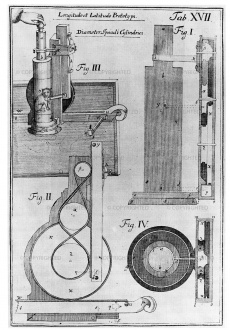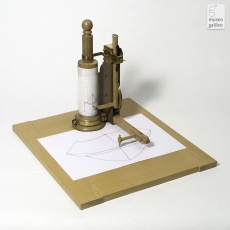Instrument for Cylindrical Anamorphosis
From Inventions
Has no specific name.
Contents |
Inventor
Jacob Leupold (1674-1727)
Historic Period
1713
Description
Rare instrument for drawing cylindrical anamorphoses starting from a given drawing. The instrument consists of a cylinder around which rotates a mechanical apparatus comprising a vertical rod with a metal-point indicator, two pulleys of different diameter and a horizontal rod with pen point. The rods and pulleys are connected by a single wire so that each vertical movement of the rod with the indicator is matched by a horizontal movement of the rod with pen point. The drawing to be deformed is applied to the cylinder, where the indicator follows its contour thanks to the rotation of the mechanical apparatus and the vertical sliding of the rod it is connected to. Due to the different diameters of the pulleys, the further the indicator moves upward from below, the more the pen point moves away, at ever greater increments, from the centre of the cylinder. The resulting drawing is a deformed copy of the original, a cylindrical anamorphosis whose otherwise jumbled image assumes its proper form only when reflected in a cylindrical mirror positioned in place of the instrument’s cylinder.
Bibliographical Resources
Leupold, Jacob. Anamorfosi mechanica nova, oder Beschreibung dreyer neuen Maschinen, Leipzig, 1713.
Existing Instruments
Firenze, Museo Galileo-Istituto di Storia della Scienza, modello funzionante (2001).
Images
Author of the entry: Filippo Camerota


